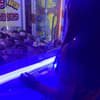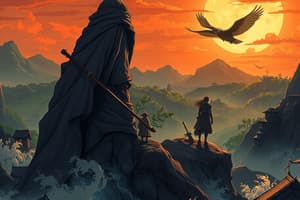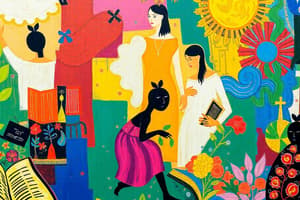Podcast
Questions and Answers
What is the typical syllable pattern in a haiku?
What is the typical syllable pattern in a haiku?
- 7-5-7
- 5-7-5 (correct)
- 4-8-4
- 6-6-6
Which aspect is commonly explored in traditional haikus?
Which aspect is commonly explored in traditional haikus?
- Nature and the seasons (correct)
- Philosophical concepts
- Emotions and feelings
- Historical events
What emotional tone does an elegy typically convey?
What emotional tone does an elegy typically convey?
- Sorrow and lamentation (correct)
- Joy and celebration
- Hope and optimism
- Indifference and neutrality
What does the term 'literature' derive from?
What does the term 'literature' derive from?
What is the rhyme scheme of a Shakespearean sonnet?
What is the rhyme scheme of a Shakespearean sonnet?
What is a defining characteristic of a sonnet?
What is a defining characteristic of a sonnet?
Which of the following best describes dramatic poetry?
Which of the following best describes dramatic poetry?
Which type of poetry focuses on storytelling elements like characters and conflicts?
Which type of poetry focuses on storytelling elements like characters and conflicts?
What distinguishes prose from poetry?
What distinguishes prose from poetry?
Which of the following best describes fiction?
Which of the following best describes fiction?
What is NOT a common form of narrative poetry?
What is NOT a common form of narrative poetry?
Which of the following statements about lyric poetry is correct?
Which of the following statements about lyric poetry is correct?
What type of poem expresses praise and admiration towards a subject?
What type of poem expresses praise and admiration towards a subject?
What is the primary purpose of poetry as a literary form?
What is the primary purpose of poetry as a literary form?
Which characteristic is NOT typically associated with the structure of literature?
Which characteristic is NOT typically associated with the structure of literature?
Which of the following literary forms is characterized by celebrating heroic deeds?
Which of the following literary forms is characterized by celebrating heroic deeds?
What is a defining characteristic of novels compared to short stories?
What is a defining characteristic of novels compared to short stories?
Which of the following is NOT a role of fiction?
Which of the following is NOT a role of fiction?
Which type of non-fiction provides a detailed account of a person’s life written by someone else?
Which type of non-fiction provides a detailed account of a person’s life written by someone else?
What is the primary purpose of reference books in non-fiction?
What is the primary purpose of reference books in non-fiction?
Which type of writing analyzes and interprets historical events and figures?
Which type of writing analyzes and interprets historical events and figures?
How can fiction provide a form of escapism for readers?
How can fiction provide a form of escapism for readers?
What common purpose do autobiographies and essays share in non-fiction?
What common purpose do autobiographies and essays share in non-fiction?
Which aspect is a primary role of non-fiction writing?
Which aspect is a primary role of non-fiction writing?
What is the primary theme explored in 'Florante at Laura'?
What is the primary theme explored in 'Florante at Laura'?
Which of the following statements is true about a soliloquy?
Which of the following statements is true about a soliloquy?
What common theme is depicted in the metrical tale 'Ibong Adarna'?
What common theme is depicted in the metrical tale 'Ibong Adarna'?
What distinguishes a ballad from a typical narrative poem?
What distinguishes a ballad from a typical narrative poem?
Which statement accurately describes 'Biag ni Lam-ang'?
Which statement accurately describes 'Biag ni Lam-ang'?
What is the structure of a traditional Haiku?
What is the structure of a traditional Haiku?
Which aspect is NOT commonly associated with metrical tales?
Which aspect is NOT commonly associated with metrical tales?
In 'El Filibusterismo', what does Simoun struggle with during his soliloquy?
In 'El Filibusterismo', what does Simoun struggle with during his soliloquy?
Flashcards are hidden until you start studying
Study Notes
Overview of Literature
- Derived from Latin "littera," meaning "letter of the alphabet."
- Encompasses imaginative and creative works in poetry and prose.
- Can be classified by language, national origin, historical period, genre, and subject matter.
- Exists in oral and written forms, featuring specific structures and genres.
Types of Literature
- Major forms include poetry and prose.
Poetry
- Expressive literary form using rhythmic and metaphorical language.
- Can provoke emotions, convey ideas, and explore universal themes.
- Varieties include sonnets, haikus, and free verse.
Types of Poetry
-
Narrative Poetry: Tells a story with characters, setting, and conflict.
- Epic: Long narrative poem celebrating heroic deeds (e.g., "Biag ni Lam-ang").
- Ballad: Short stanzas meant to be sung, often emotional (e.g., "Florante at Laura").
- Metrical Tales: Straightforward narrative poems focused on everyday lives (e.g., "Ibong Adarna").
-
Dramatic Poetry: Intended for performance, includes themes of conflict and emotion.
- Soliloquy: A character's speech revealing inner thoughts (e.g., Simoun’s Soliloquy in "El Filibusterismo").
-
Lyric Poetry: Focuses on personal emotions and thoughts, often musical.
- Haiku: Japanese form with a 5-7-5 syllable pattern, usually about nature.
- Ode: Expresses praise or admiration (e.g., "Ode to the Sea" by Jose Rizal).
- Elegy: Laments loss or mourning (e.g., "Mi Ultimo Adios" by Jose Rizal).
- Sonnet: 14 lines exploring themes of love; variations include Shakespearean and Petrarchan forms.
Prose
- Written or spoken language following natural speech patterns, common in various contexts.
- Divided into fiction and non-fiction.
Types of Prose
-
Fiction: Imaginative works featuring invented characters and plots.
- Novels: Extended works with complex plots (e.g., "Pride and Prejudice" by Jane Austen).
- Short Stories: Brief narratives focusing on a single event (e.g., "The Lottery" by Shirley Jackson).
- Roles: Entertainment, reflection of human behavior, and escapism.
-
Non-Fiction: Based on factual information, real events, and people.
- Types include biographies, autobiographies, essays, historical writing, and reference books.
- Roles: Education, inspiration, and documentation of events and experiences.
Studying That Suits You
Use AI to generate personalized quizzes and flashcards to suit your learning preferences.





